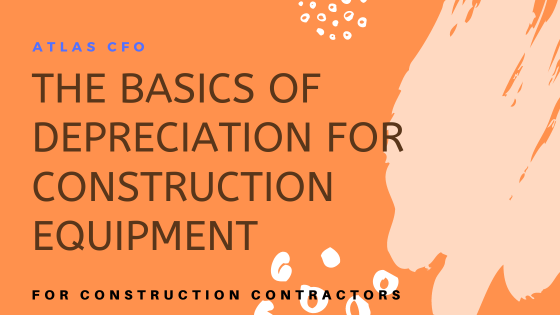As a construction business owner, one of your significant investments is the construction equipment you acquire. Depreciation is a natural and necessary expense when a company purchases these long-term construction assets. Understanding depreciation is crucial for managing your finances effectively and making informed decisions. Additionally, there are several different methods of depreciation, and we’ll break down the details here.
- What is Depreciation?Depreciation is an accounting concept that reflects the decrease in value of an asset over time. Construction equipment, such as heavy machinery, vehicles, and tools, depreciates due to wear and tear, technological advancements, and market changes. By recognizing this loss in value, you can accurately reflect the equipment’s impact on your company’s financial statements.
- Accurate tracking of equipment depreciation offers several benefits for construction businesses and is necessary for both internal GAAP based financial statements and for your taxable net income calculation for your tax return:
- Financial Statements (Book/GAAP): Recognizing depreciation in your financial statements provides a more accurate picture of the company’s financial health. Depreciation on the Book/GAAP basis should match the expense with the useful life of the equipment. For book depreciation, straight line depreciation (see below) is most commonly used.
- Tax Methods: Depreciation is a tax deduction that reduces your taxable income. By appropriately tracking depreciation, you can minimize your tax liability and improve cash flow. Tax depreciation is based on method and lives as allowed by the IRS. It is perfectly normal to have TWO different fixed asset schedules with different depreciation amounts per year.
- Depreciation Methods:There is more than one way to calculate depreciation, but there are common methods for Book/GAAP and tax. We’ll cover a couple of the most common ones.
- Straight-Line Depreciation: This method calculates an equal depreciation expense over the asset’s useful life. It is simple to understand and implement. This method is most common for internal/GAAP based financial statements. Useful life should represent the true useful life of the asset, so consider how long you will use the asset. The formula for straight-line depreciation is:Depreciation Expense = (Cost – Salvage Value) / Useful Life
- Declining Balance Method: This method allows for greater depreciation deductions in the early years, gradually decreasing over time. It is suitable for assets that are more productive in their initial years. The formula for declining balance depreciation is:Depreciation Expense = (Net Book Value – Accumulated Depreciation) * Depreciation Rate
- Special bonus depreciation methods: There are additional bonus depreciation for tax purposes. Section 179 allows for full depreciation of an asset in the year it was purchased based on limits established by the IRS and Congress. There can be 50% bonus depreciation or even special state depreciation bonuses.
- Enhancing Equipment Depreciation Management:To effectively manage equipment depreciation and maximize profitability, consider the following strategies:
- Accurate Asset Tracking: The most common place for assets to be tracked is with your outside tax accountant. As your tax accountant needs your fixed asset information, having them maintain your records works great. Make sure to ask them to prepare BOTH a Book schedule and a Tax schedule. This will allow you to feel confident on the calculations, streamline the data and allow for both book and tax schedules.
- Capitalization Policy: The company needs to establish a capitalization policy. A capitalization policy provides guidelines for when a purchase goes on the asset schedule versus when it is expensed. The current IRS guidelines for asset purchases is $2,500. This amount is based on a per item, not total. As an example, if you buy 200 ladders, it would be expensed
- Lease vs. Buy Analysis: When considering acquiring new equipment, evaluate whether it is more cost-effective to lease or buy. Leasing can offer certain tax advantages and flexibility, while buying may provide long-term savings. We recommend that you consult your outside accountant as the accounting treatment of leases has changed.
Conclusion:
Understanding depreciation for construction equipment is essential for financial management and decision-making in the construction business. Implementing effective systems for equipment depreciation management will ultimately contribute to increased profitability and the long-term financial health of your construction company.

